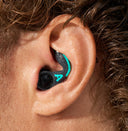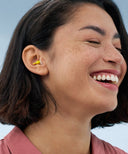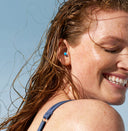Surfer’s ear isn’t just something surfers need to worry about. Anyone who spends a lot of time in the water—whether surfing, kayaking, wakeboarding, or swimming—can develop this condition. It often goes unnoticed for years but can eventually lead to serious issues. In this article, we’ll break down what surfer’s ear is, what symptoms to look out for, when you're most at risk, and how you can help prevent it.
What is surfer's ear?
Surfer's ear or external auditory exostosis (EAE) is a condition that involves abnormal bone formation in the ear canal. This occurs as a physical response to repeated exposure to cold wind and water. The bony growths (exostoses) are real bone and not cartilage. They thicken and cause a gradual narrowing of the ear canal. As a result, earwax and dirt can accumulate increasingly easily. This can lead to frequent ear infections and/or partial deafness. In severe cases, the ear canal can even become completely blocked and the exostoses must be surgically removed. That's no small matter!
Are swimmer's ear and surfer's ear the same thing?
Surfer's ear (exotosis externa) and swimmer's ear (otitis externa) are two different conditions. With surfer's ear, subcutaneous bone formation occurs in the ear canal. Swimmer's ear involves inflammation of the skin of the outer ear.
The fact that swimmer's ear and surfer's ear are still sometimes confused is unsurprising; both conditions are related to water and your ears.
Surfer's ear symptoms and complaints
Recognising surfer's ear is difficult, mainly because the symptoms are subtle at first. Here are some common signs:
-
Blockage or pressure in the ear
Surfer's ear is often accompanied by the feeling that your ears are blocked or full. You may also experience discomfort due to pressure in one or both ears.
-
Water stays in your ears more often
We all experience water retention in the ear from time to time. Does water stay in your ear after showering, swimming or water sports more often than previously? If so, this could be a sign of surfer's ear.
-
Frequent ear infections
Bone growth causes narrowing of the ear canal. As a result, water and bacteria cannot leave your ear canal as easily and you are more likely to get ear infections.
-
Ear discharge (otorrhea)
You might notice fluid coming from your ears, especially after being in the water. However, fluid secretion from the ear also occurs with surfer's ear.
-
Frequent ear congestion
In most cases, earwax leaves the ear naturally. But with a narrower ear canal, it is not as easy. Earwax can then build up faster, which can cause ear congestion.
-
Tinnitus
Because moisture, dirt and earwax can no longer properly drain, surfer's ear can sometimes be accompanied by tinnitus.
-
Temporary or progressive hearing loss
Because hearing loss usually occurs gradually, you often don't notice it at first. As the condition progresses, you may begin to notice that sounds sound muffled - especially if there is background noise.
-
Dizziness
Parts of your ear associated with hearing are connected to your vestibular system. This can also be affected by inflammation of the ear canal, resulting in frequent dizziness.
If you take part in water sports and experience some of the above symptoms, you may be developing surfer's ear. A general practitioner or ENT specialist can take a closer look and advise on treatment. In the meantime, make sure your ears are well protected when you spend time in water (more on this later).
When are you (more) at risk of surfer's ear?
According to Stanford Health Care, people who surf regularly for 20 years have as much as a 50% chance of developing significant ear canal blockages due to ear exostoses. But as mentioned, the condition is not limited to surfers. Other water sports enthusiasts whose ears are frequently exposed to cold water and wind for long periods of time are equally at risk. Research shows that repeated exposure to water below 64°F (18°C) significantly increases the chance of developing the condition. Wind chill makes the risk even greater.
It is important to note that surfer's ear does not develop overnight. It may take years of frequent exposure. If you participate in water sports a few times a year, you should have no immediate concerns. However, it is recommended that you always take preventive measures - after all, surfer's ear does not go away by itself!
What should you do if you think you have surfer's ear?
Do you suspect you have surfer's ear? If so, it is important to have it checked out as soon as possible. Over time, surfer's ear can lead to serious complications that may require surgery. This surgery, known as canaloplasty, involves removing the exostosis in the ear canal. Such procedures are not without risks and have a long recovery period. Early detection is the key to effective treatment. See your primary care provider or ask for a referral to an ENT (ear, nose, and throat) specialist for a full evaluation and treatment plan.
How can you prevent surfer's ear?
Surfer's ear is basically your body's desperate attempt to protect your eardrum from cold water and cold wind. To prevent this from happening, it is crucial to protect your ears yourself . Prevention is by far the best approach when it comes to surfer's ear.
Wear the right protective earplugs
Do you often experience water retention in your ears after swimming? This is easily prevented by using high-quality hearing protectors, such as Alpine's SwimSafe earplugs. These can also be custom made especially for you! For water sports enthusiasts, Alpine's WaterSafe Pro earplugs are the solution. These water sports earplugs fit comfortably and securely, and stay in place even in the highest waves. They are designed to keep (cold) water out, while sounds remain audible. This is especially important for surfers, since you often have to share the waves with others. The ability to understand each other is then essential to avoid dangerous situations. Of course, earplugs also help against cold wind in your ears.
Use a (neoprene) swim cap
A well-fitting (neoprene) swim cap protects your ears from the wind and reduces the amount of water entering. An added benefit is that your hair also stays (mostly) dry.
Dry your ears after showering and swimming
Water in your ear after showering usually drains out on its own by tugging your earlobe a few times or holding your head to the side. Always dry your ears thoroughly after you have been in water. If you are at the beach, watch out for sand and make sure the towel you use is clean.
Limit exposure to cold water and wind
Do not enter the water without protection to avoid problems. If you do occasionally forget your earplugs or swim cap, try to limit the time you spend in or on the water.
Put a beanie on as soon as you get out of the water
Get used to putting on a beanie after water sports. Your head and ears then warm up faster.
Conclusion: embrace the waves but protect your ears
Surfer's ear does not have to be a barrier between you and the water. But don't take unnecessary risks. With the right precautions and hearing protection, you can continue to enjoy the waves without endangering the health of your ears. Alpine encourages all water lovers to take hearing protection seriously. We wouldn't want you to miss out on hearing the sounds of the sea.
This article is for informational purposes only and does not replace medical advice. Have questions about your health? Contact a doctor or healthcare provider.




